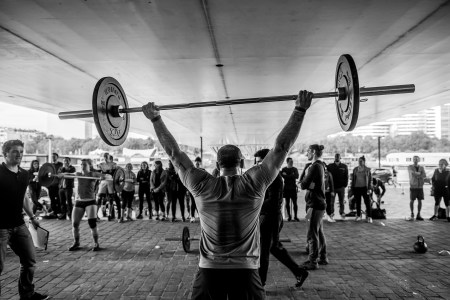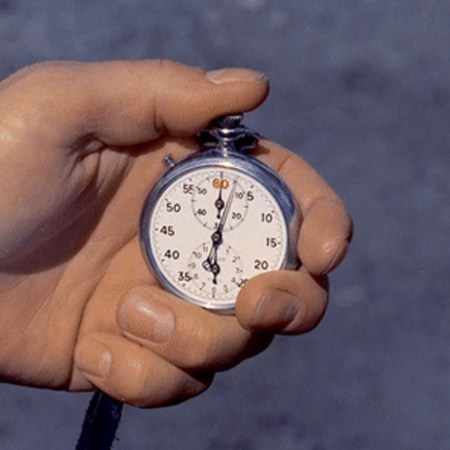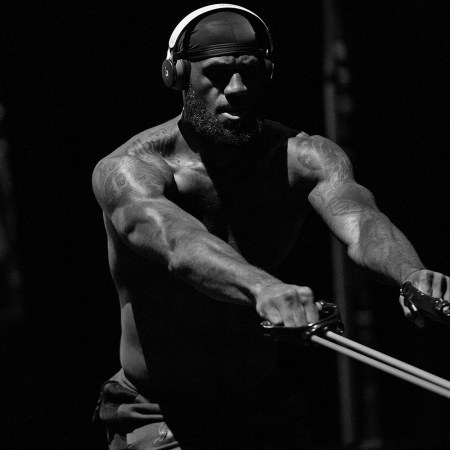There’s a video that went viral last year of a man deadlifting what appears to be an entire yard sale. Hanging from his neck, shoulders and waist are chains, bars, weighted plates, baseball bats, paint cans, propane tanks, boomboxes and wind chimes, all of which clank and rattle as he struggles through a single repetition.
The sentiment online is pretty unanimous: What in god’s name is this guy training for?
We can’t know for sure (though it looks like he’s a former Division 1 wrestler, who claims to own the world record for deadlifting on a skateboard), but as you might have intuited, this sort of training is unnecessary, time-consuming, dangerous and more or less insane. It’ll also require you to clean out your garage — no gym manager is going to stand for this sort of nonsense.
That said, there are some elements to his scrap-metal fitness that intersect with a respected and underrated form of strength training: it’s called chaos training. The name might elicit images of trainees running around gyms on all fours, sweating profusely as they get screamed at, but chaos training isn’t as menacing as it sounds. It’s simply a method of adding instability to traditional exercises.
The Leap of Faith That Could Whip You Into Shape
Workout classes change lives. We spoke to a panel of devotees.Intro to Chaos Training
The “chaos” generally arrives in the form of an added weight dangling from a bar, though it can also include moves that take you (or a weight) off a mat or bench and into the air. Some recognize an even more liberal definition than that, and use the phrase to qualify any sort of regimen that encourages unconventional moves designed to “shock” the body.
What’s the point of it? Chaos training is meant to get you out of a rut in the gym by engaging your brain and body with unfamiliar patterns. Routine is king in fitness, but routine without creativity leads to inevitable plateaus. Chaos training takes a tried-and-true format (the bench press, for example) and forces it to engage with smaller, secondary, “stabilizer” muscles that are often left unused during the exercise.
Imagine you’ve strung a pair of kettlebells from either side of the bar. As they swing to and fro (chaos!), your muscles, tendons, joints and ligaments all have to work a bit harder than usual to properly perform the exercise. It doesn’t matter how many times you’ve lifted this amount of weight before; this time is different. It engages some of functional strength training’s most important tenets — mind-muscle connection, time under tension, grip strength — while mimicking some of the benefits of “unconventional training.” When you work out with a mace, for instance, or a sandbag, the weight is either farther away from you than usual and/or moving around. You have to work harder to keep the operation under control.
Why It Works
There was a study published in 2017 in the Journal of Strength and Conditioning Research that does a good job of explaining these ideas: “During an unstable condition, the bar moved in more ways and was less predictable in the mediolateral and anteroposterior directions. However, the muscle activation patterns of all muscles were more constrained with the unstable barbell. These findings suggest that the unstable condition was more challenging to control, but subjects controlled the instability by contracting their muscles in a more stable pattern or ‘staying tight’ throughout the exercise.”
Put simply, chaos training will tighten you up. But that doesn’t mean you should only train with baseball bats swinging from your EZ bar. Like other lifting hacks (think BFR training, or push-pull routines), you want to incorporate chaos training into your larger regimen only on occasion for maximum effect.
Start slow. Master a handful of moves, and perform three to four high-rep sets (no more than 20 reps per exercise every couple weeks). Then take note of the impact it’ll have on your “boring” workouts — they should feel loads easier — not to mention your general drive to get in the gym. As always, it helps to have a few sure-fire moves to turn to before taking the plunge. We’ve identified some of our favorites below.
Chaotic Carries
There are both upper-body exercises (e.g., bench press, overhead press) and lower-body exercises (e.g., deadlifts, kettlebell swings) that can easily be converted for chaos training. But one of the best full-body exercises primed for a dose of chaos is the classic farmer’s carry.
Using resistance bands, affix 10-pound weights from either side of a barbell. If you’re in a gym, you’ll want to walk for time — back and forth for a minute or more. Repeat three times. If it’s warm out and you can get yourself to a field, try to walk the full 100 yards. You can hold the bar against your body, with your arms flexed towards your chest, or you can hold it straight in the air (warning: this is tough as hell) for an overhead carry. Remember to keep the weight light, but if for some reason you’re feeling nothing, consider graduating to a hex bar. The shape will make it a bit easier to stack on traditional weight on top of the chaos weight you’ve affixed via the bands.
Meet the Medicine Ball
Give a trainee a medicine ball, and he’ll likely perform a bunch of Russian twists. But there are other, more dynamic and chaotic exercises to employ with a weighted ball.
One of the best? Medicine ball squat jumps. Simply cradle a 10-pound ball in your arms and explode into the air over and over again, 15 reps total. The trick is to get deep enough in the legs without spending too much time in contact with the floor. Look to perform three or more sets, with a few minutes of rest in between each. While you’ve got that ball out, you’ll also want to pick a spot on the wall. Orient yourself under it and heave the ball up; upon catching it, bend right into a squat. Try to keep a fluid, steady motion as you knock out 10 reps at a time. Three sets will work wonders. Here’s a fantastic demo. These sorts of exercises — and others, like plyometric pushups — rely on motion to channel instability, as opposed to jerry-rigged resistance bands.
Bamboo > Steel
That said, learning to tie resistance bands to free weights, racks in the gym and poles is going to open up an entire world of workout options. In addition to dangling plates from barbells, you can loop elastic bands through dumbbell rods (here’s a handy tutorial on how to make that happen), or create “chaos pushups” by snaking heavier bands around squat racks at varying heights. Check it out here.
Be very careful with these, considering you could easily land on your nose. One other piece of equipment that’s going to come in handy for chaos training is a bamboo bar, sometimes called an “earthquake bar.” The thing can take up to 300 pounds of weight, but it’s intentionally designed to bend and shake (hence the nickname), which is going to set your stabilizers on fire. You’re probably not going to find one of these at the health club, but if you’re building up your garage gym anyway, you could do worse than fortifying the weak points in your shoulders and chest with this thing.
Just promise that once you get a taste for fun in the garage that you’ll leave it at that. We don’t need you deadlifting lawn mowers and lacrosse sticks anytime soon.
Whether you’re looking to get into shape, or just get out of a funk, The Charge has got you covered. Sign up for our new wellness newsletter today.
























